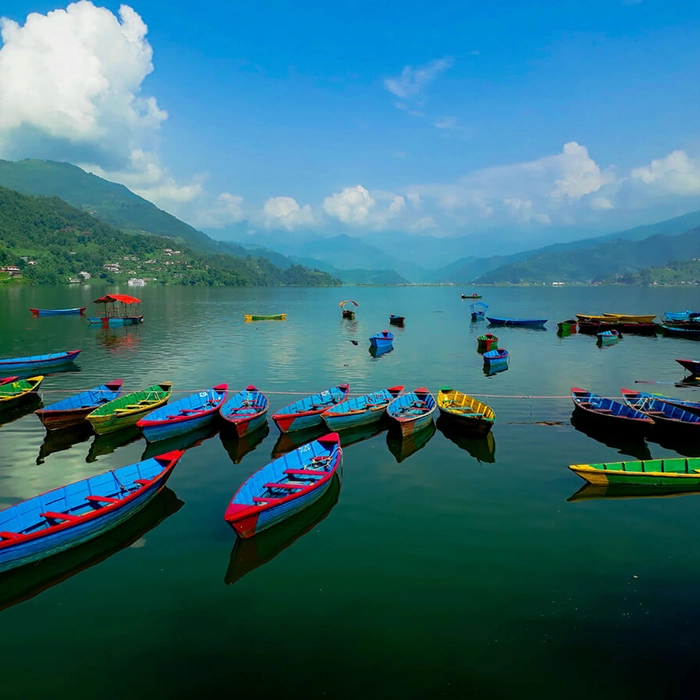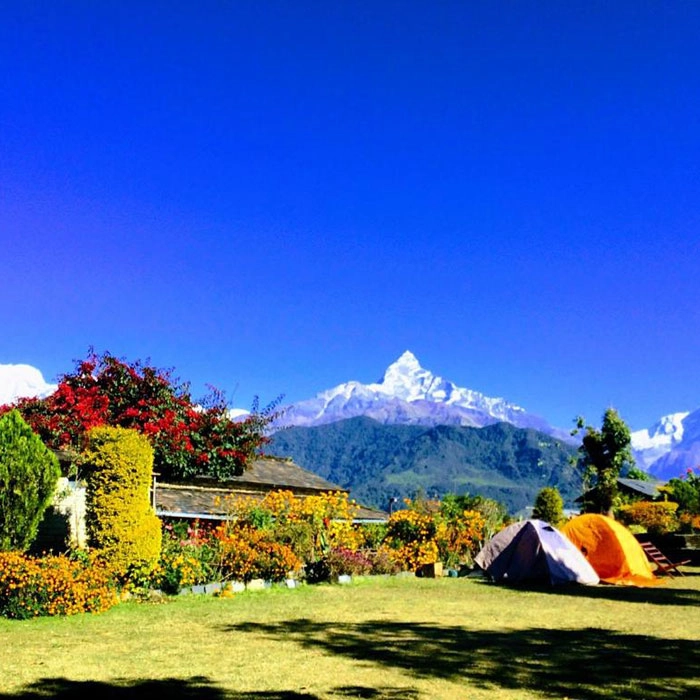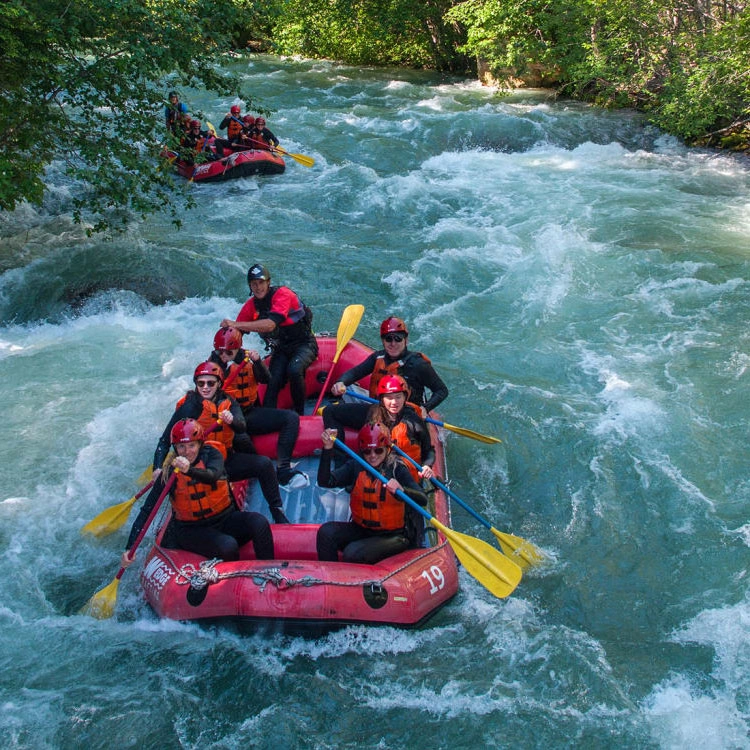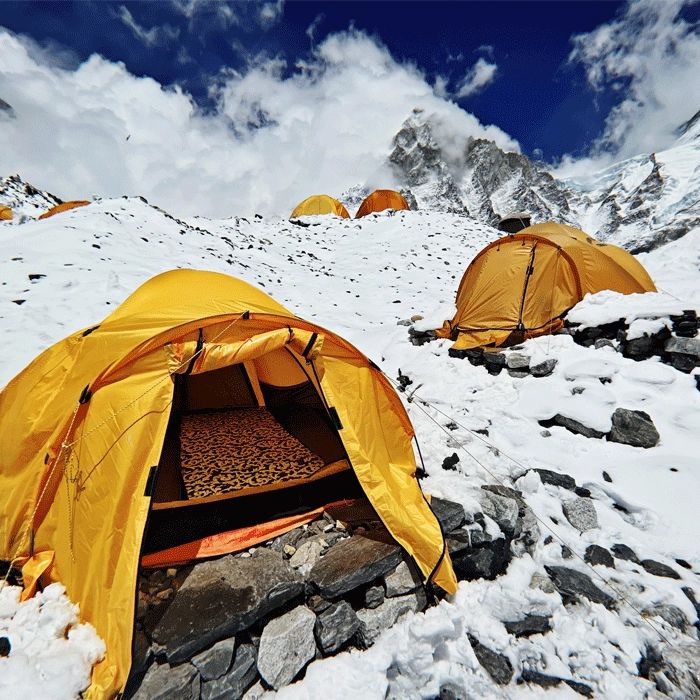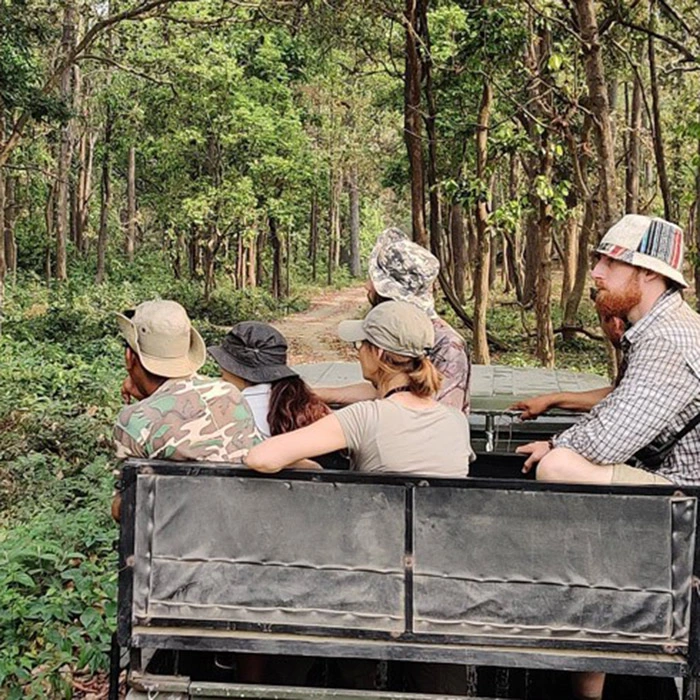MERA PEAK EXPEDITION
US$3,330.00
/pp
-
18 Days
-
Everest
-
Spring/Autumn
-
Trek & Climb
-
6,476 Meters
-
Strenuous
-
Car / Plane
-
02-16 People
-
JH#233
 Overviews
Overviews
Mera Peak Expedition is one of the highest trekking joruney to reach to Mera Peak in Nepal , which is situated in the Everest region to the east of the main Khumbu trekking route, Mera Peak stands at 6,476 meter above sea level. The trail follows by crossing the high ridges and spectacular deep river gorges of the Sherpa homeland of Everest region before entering the less-frequented wilderness of the Hinku valley. The climb to the top of the Mera Peak provides a chance to see the amazing views of Everest, Lhotse, Makalu, Kanchenjunga and Cho-Oyu. The best times for Mera Peak Expedition are spring and autumn. Mera Peak Climbing offers stunning panoramic views of five 8,000-meter peaks: Kanchenjunga, Makalu, Lhotse, Everest, and Cho Oyu. Mera Peak trekking and climbing route can be suitable for fit and experienced hill walkers, who are looking to take part in Himalayan peak climbing. We will continue this trekking to the northwards into the Khare of the Mera Peak. Before ascending to Mera Peak (6,476 m) you have to sleep one night in a tented camp at a high camp, managed by a local lodge in Khare. We provide standard accommodation (twin share bed room) during trekking and excellent tented camp at Mera Peak High Camp. Trekkers will continue hiking to the Khare passing the hidden Buddhist monasteries, Sherpa culture and magnificent views of surrounding peaks. If you are capable of making this trip, no need to worry about trekking in this Mera Peak Expedition, because our trekking guide will make it a safe and lifetime memorable journey. After having a taste of the sublime beauty of Mera Peak your journey ends and you need to go back to Lukla to take a short flight to Kathmandu. The best time for Mera Peak Expedition is spring and autumn. Mera Peak Climbing Difficulty Mera Peak Expedition is considered a challenging but non-technical climb, suitable for physically fit trekkers with basic mountaineering experience. Standing at 6,476 meters (21,247 ft), Mera is the highest trekking peak in Nepal, and the main difficulty lies in the altitude, long duration, and endurance required, rather than technical climbing. The ascent involves glacier walking, use of crampons and ice axe, and sometimes fixed rope sections, particularly near the summit. Trekkers typically spend 6 to 8 hours per day hiking, with summit day being the most strenuous. Proper acclimatization, physical training, and a strong mindset are essential for success. With professional guides and good preparation, Mera Peak offers an exhilarating high-altitude adventure with stunning views of Everest, Makalu, and Kanchenjunga. Mera Peak Climbing CostThe Mera Peak Expedition cost typically covers all essential services, including a licensed guide with climbing experience, porter support, Everest region permits, camping or teahouse accommodations, all meals during the expedition, ice gear (crampons, ice axe, harness, ropes), and round-trip ground or flight transportation to and from the trailhead. Solo climbers receive personalized attention, while groups benefit from tiered pricing, with per-person rates dropping as group size increases. We also offer seasonal discounts to make this high-altitude challenge more accessible. Although our website lists standard international pricing, you can contact us directly for private-group quotes, where we promise the best possible value without compromising safety, gear quality, or service standards for your Mera Peak adventure.
 Itinerary (Plan)
Itinerary (Plan)
Arrive in Kathmandu, Nepal's vibrant capital, where you'll be warmly welcomed with marigold garlands. After transferring to your hotel, take time to relax and acclimate to the bustling city. Discover vibrant local markets, indulge in traditional Nepali dishes, and delve into Kathmandu's rich cultural tapestry. This initial day is perfect for easing into your journey, setting the stage for the exciting adventures ahead in Eastern Nepal. A representative from Jagadamba Holidays will ensure a smooth and pleasant arrival.
Optional Evening Activity:
If you wish, you can spend your evening experiencing the Pashupatinath Aarti, a captivating religious ceremony held at the Pashupatinath Temple. The Aarti usually begins around 6:00 PM and lasts for approximately an hour. This ceremony is a mesmerizing display of traditional music and rituals, providing a profound insight into Hindu spiritual practices. Please check the exact time for the Aarti on the day of your visit, as it may vary. This option is not included in the standard itinerary but offers a unique opportunity to immerse yourself in local culture.
Typically, trekkers fly from Kathmandu to Lukla (2,846 m / 9,350 ft) to begin their journey. However, if a direct flight is unavailable, an alternative route via Ramechhap and Manthali may be necessary. When flying from Manthali, if time permits, explore the stunning Kathmandu Valley before driving 132 kilometers (about 4 hours) to Manthali for an overnight stay. If your schedule is tight, a pre-dawn departure at 2 AM from Kathmandu ensures timely arrival for your flight on Day 2.
Upon arrival in Lukla, take time to rest and acclimatize before setting off on your trek towards Paiya (2,730 m / 8,957 ft) via Surke. This scenic trek spans approximately 10 kilometers and takes 5 to 6 hours, involving an ascent of 620 meters and a descent of 720 meters.
The trail offers spectacular natural beauty, winding through vibrant forests, traditional Sherpa villages, and breathtaking landscapes. As you trek alongside the Dudh Koshi River valley, enjoy panoramic views of rolling hills and towering snow-capped peaks. The soft murmur of the river and the songs of native birds create a peaceful soundtrack to your journey.
Passing through pine forests and rhododendron groves—especially vivid in spring—the path alternates between open valleys and shaded woodland. This rich ecosystem highlights the Himalayan region’s biodiversity and pristine environment.
Paiya village welcomes trekkers with warm hospitality in its modest teahouses. Here, immerse yourself in authentic Sherpa culture by engaging with locals who proudly share stories of their heritage and everyday mountain life. As night falls, the serene Himalayan setting deepens your connection to this remarkable land.
After breakfast at the lodge, begin your trek to Panggom, situated at 2,750 meters (9,022 feet). This trek covers approximately 12 kilometers and takes around 5 to 6 hours, involving an ascent of 820 meters and a descent of 690 meters.
The trail meanders through lush bamboo and pine forests, alive with birdsong and occasional wildlife sightings. As you climb higher, the scenery opens up to reveal terraced fields and picturesque hillside villages. Upon reaching Panggom, a traditional Sherpa village, you’ll be greeted by monasteries and rows of fluttering prayer flags, reflecting the deep Buddhist heritage of the community.
A stroll through the village offers intimate insight into Sherpa life, with locals dressed in traditional attire and practicing spiritual customs. Panggom is renowned for its warm hospitality; visitors are often invited to learn about Sherpa traditions, explore the vibrant local market, or visit families to observe authentic Sherpa cooking techniques.
The community takes pride in preserving their cultural heritage, celebrating ancient rituals and festivals throughout the year. As evening falls, enjoy the tranquil ambiance of the village, surrounded by stunning Himalayan vistas — the perfect way to end a day filled with trekking and cultural immersion.
After breakfast at the lodge, set out on your trek to Ramailo Danda, perched at 3,276 meters (10,746 feet). This scenic trek covers approximately 7.5 kilometers and typically takes 5 to 6 hours, with an ascent of 820 meters and a descent of 490 meters.
The trail gently climbs through vibrant pine and rhododendron forests, offering a spectacular burst of color during spring when the rhododendrons bloom in full glory. As you ascend higher, the thick forest gradually gives way to tranquil landscapes and sweeping, breathtaking vistas, a hallmark experience on the Mera Peak Treks route.
Upon arrival at Ramailo Danda, be rewarded with some of the most stunning Himalayan viewpoints in the region. The vantage point overlooks sweeping valleys, distant snow-capped mountain ranges, and traditional villages dotting the hillsides. It’s a perfect spot for photography enthusiasts and nature lovers alike, providing a tranquil environment to relax and soak in the breathtaking scenery.
Ramailo Danda’s peaceful atmosphere and mesmerizing views offer a unique opportunity to connect with the rich cultural heritage and natural beauty of Nepal’s highlands. Breathe in the crisp alpine air and enjoy breathtaking Himalayan views before resting comfortably at cozy local teahouses, immersing yourself in authentic Nepal trekking hospitality.
After breakfast at the lodge, begin your scenic trek to Thak Tok, a remote mountain village situated at 3,670 meters (12,041 feet). The journey covers approximately 8.5 kilometers and takes around 6 to 7 hours, with a total ascent of 1,000 meters and a descent of 640 meters.
As you navigate the rugged Himalayan terrain, the trail offers a truly authentic high-altitude trekking experience. You’ll pass through steep ridges, cascading mountain streams, and open alpine meadows where yaks graze beneath snow-capped peaks. With each step, the landscape evolves into sweeping mountain vistas and dramatic valleys, making it one of the most rewarding segments on the Mera Peak trek.
Thak Tok is a secluded Sherpa settlement tucked away in the remote highlands. Untouched by modern development, it offers a rare and intimate window into traditional mountain life in Nepal. Here, locals live in harmony with nature, following age-old customs and a sustainable lifestyle shaped by the high-altitude environment.
This peaceful village is perfect for trekkers seeking cultural immersion, off-the-beaten-path adventure, and a deeper connection with the Himalayas. It’s a chance to experience genuine Sherpa hospitality and observe the enduring spirit of the communities who thrive in these remote landscapes.
After breakfast at the lodge, begin your rewarding trek to Kothe (3,580 m / 11,745 feet), following a scenic trail through the heart of the Himalayan forest landscape. This short yet immersive trekking day covers approximately 3 kilometers and takes around 3 to 4 hours, with a gentle ascent of 210 meters and a descent of 240 meters.
The trail winds through lush Himalayan pine and rhododendron forests, offering a peaceful Nepal trekking experience enhanced by birdsong and fluttering prayer flags. You’ll cross suspension bridges over clear mountain streams and enjoy picturesque views of the Hinku Valley, a remote and pristine region of eastern Nepal known for its dramatic scenery and biodiversity.
As you approach Kothe, the landscape opens to reveal a peaceful riverside village surrounded by lush greenery and towering cliffs. Nestled along the banks of the Hinku Khola River, Kothe is home to a small Sherpa community, where you’ll experience authentic mountain hospitality in one of the region’s coziest stops on the Mera Peak trekking route.
Interacting with the locals offers insight into Buddhist culture, traditional Himalayan farming practices, and the resilience of life in remote Nepalese villages. This part of the journey offers a meaningful cultural exchange as well as a restful stop before continuing toward higher elevations.
After breakfast, continue your high-altitude journey to Thangnak (4,358 m / 14,298 ft), a key acclimatisation stop on the Mera Peak trekking itinerary. This high-altitude trek covers approximately 8.5 kilometers, taking 4 to 5 hours, with a steady ascent of 700 meters and a slight descent of 10 meters. The route offers an authentic Himalayan trekking experience through remote, glacially carved valleys and pristine mountain wilderness.
The trail follows the breathtaking Hinku Valley, weaving through landscapes defined by glacial moraines, alpine scree, and icy meltwater streams. As you trek alongside the glacier-fed rivers, enjoy spectacular views of peaks like Kusum Kanguru, Mera Peak, and surrounding snow-covered ridgelines. This section of the Everest region trek offers ideal opportunities for photography, nature appreciation, and high-altitude acclimatisation.
Arriving in Thangnak, a peaceful Sherpa settlement surrounded by dramatic Himalayan vistas, you’ll experience a quiet and spiritual atmosphere far from the bustle of modern life. Sacred prayer wheels, carved mani stones, and rows of fluttering prayer flags line the village paths, offering a vivid reflection of the rich Himalayan Buddhist traditions that thrive in the heart of Nepal’s Solu Khumbu region. Local teahouses provide hearty meals and warm hospitality, making this a perfect place to rest and prepare for the ascent to Mera Peak Base Camp.
Ideal for both seasoned climbers and first-time trekkers, this section of the Mera Peak trail offers a rewarding blend of stunning Himalayan scenery and rich Sherpa cultural experiences. The increasing altitude and rugged terrain add a thrilling mountaineering challenge, making it a true highlight of any Nepal climbing adventure.
After breakfast, begin your trek to Khare (5,045 m / 16,550 ft), following challenging high-altitude trails with breathtaking Himalayan mountain views. This trek covers approximately 5.5 kilometers and takes around 4 to 5 hours, featuring a steady ascent of 600 meters and no descent.
The route to Khare is famous among Mera Peak climbers and high-altitude trekkers for its dramatic and rugged scenery. Glaciers, rocky slopes, and expansive panoramic vistas of towering Himalayan peaks surround you as you ascend, offering an immersive experience deep in the heart of Nepal’s Himalayas. The challenging terrain and thin mountain air make this trek a vital part of your Mera Peak acclimatization process.
Khare is the essential base camp for climbers preparing to summit Mera Peak, Nepal’s highest trekking peak. This remote mountain village offers basic yet comfortable accommodation options and a vibrant atmosphere where international trekkers and mountaineers gather to rest, acclimatize, and share inspiring adventure stories. The strategic location of Khare makes it a crucial stop on your Mera Peak expedition itinerary.
For additional acclimatization and adventure, trekkers can embark on optional short hikes to nearby ridges or smaller peaks around Khare. These side trips provide stunning views of glaciers, snow-capped summits, and the vast Himalayan landscape, enriching your high-altitude trekking experience and helping prepare you physically and mentally for the upcoming summit attempt.
Experience authentic Sherpa hospitality, mountain culture, and the thrill of trekking through Nepal’s pristine wilderness as you rest and recharge in Khare, the gateway to one of the most rewarding Himalayan climbs.
After a hearty breakfast at your lodge, spend a crucial acclimatization day in Khare (5,045 m / 16,550 ft) to prepare for your upcoming Mera Peak summit attempt. This rest day is vital for adjusting to the high altitude, reducing the risk of altitude sickness, and thoroughly checking your climbing gear for the challenging ascent ahead.
Take advantage of the day with optional short hikes around Khare, specially designed to boost acclimatization and improve your stamina. These easy treks offer breathtaking views of the surrounding glaciers, icefalls, and towering Himalayan peaks, while allowing you to practice essential climbing skills in a controlled environment.
In the afternoon, embark on a rewarding trek to Mera Base Camp (5,350 m / 17,550 ft), a key acclimatization point on your Mera Peak expedition. Here, you can familiarize yourself with the rugged terrain and extreme weather conditions expected during the summit climb. This strategic visit to base camp strengthens your high-altitude readiness and mental focus for the ascent to High Camp.
Khare’s serene mountain atmosphere buzzes with excitement and anticipation as trekkers and climbers prepare for the final phase of their journey. Local Sherpa guides, experts in high-altitude expeditions, share invaluable advice on climbing techniques, weather patterns, and safety protocols to ensure you are well-prepared.
Spend the evening relaxing in Khare, resting your body and mind in cozy mountain teahouses. This essential acclimatization day sets the foundation for a successful and safe Mera Peak summit bid, blending adventure, culture, and Himalayan wilderness.
After a nourishing breakfast at the lodge, begin your demanding trek to High Camp (5,780 m / 18,958 ft), the critical staging point before the ultimate ascent to the Mera Peak summit (6,461 m / 21,198 ft). Covering approximately 4.5 kilometers in 5 to 6 hours, this high-altitude trek involves a steady ascent of 900 meters without any descent.
The trail to High Camp presents a challenging climb, as the terrain grows steeper and snow and ice become more prevalent. Surrounded by majestic Himalayan peaks, you’ll navigate rugged paths that highlight the raw beauty and formidable nature of the high mountains. Each step brings more breathtaking panoramic views of some of Nepal’s tallest giants, fueling your determination.
At High Camp, climbers rest in tented camps that provide essential shelter amid the remote mountain wilderness. This camp is the final base where climbers prepare and acclimatize for the early-morning summit push to Mera Peak. The atmosphere is filled with focused energy as trekkers double-check their gear, review climbing strategies, and mentally gear up for the challenging climb ahead.
The clear, crisp night sky at this altitude offers spectacular stargazing opportunities, creating a peaceful and inspiring environment to rest before the big day. Conserving energy here is crucial to ensure a successful and safe summit attempt of Mera Peak, one of Nepal’s most iconic high-altitude climbs.
Begin your pre-dawn summit push to Mera Peak (6,476 meters / 21,247 ft), one of Nepal’s highest trekking peaks and a coveted challenge for mountaineers worldwide. This demanding ascent covers roughly 9 kilometers and takes 10 to 12 hours, involving steep climbs over snowy ridges, icy patches, and rocky terrain. With a vertical gain of about 590 meters to the summit and a 1,500-meter descent back to Khare, this trek requires strong physical endurance, mental determination, and alpine experience.
As you climb higher, you’ll be rewarded with spectacular panoramic views of the Himalayas’ giants—Everest, Lhotse, Makalu, and Cho Oyu—dominating the horizon. Standing atop Mera Peak offers an unmatched feeling of triumph, with panoramic views of towering snow-covered peaks, expansive glaciers, and dramatic Himalayan ridges stretching as far as the eye can see. This unforgettable moment atop one of the world’s tallest trekking peaks etches itself into your memory forever.
The journey back to Khare provides a chance to reflect on your remarkable climb, as the stunning mountain scenery unfolds in fresh and inspiring ways with every step downward. Although less strenuous, the return trek offers time to celebrate your success with fellow climbers and absorb the serene mountain atmosphere at lower altitudes.
This Mera Peak expedition blends the exhilaration of high-altitude climbing with the pristine beauty of the Nepalese Himalayas. It’s a perfect choice for adventure seekers seeking a challenging yet rewarding mountaineering experience that combines natural wonders, cultural immersion, and the thrill of conquering one of Nepal’s iconic peaks.
Including a buffer day in your Mera Peak expedition itinerary is essential for ensuring a safe and successful summit attempt. This extra day provides crucial flexibility to accommodate unpredictable Himalayan weather, altitude sickness recovery, and any unexpected delays that often occur during high-altitude mountaineering adventures.
The buffer day allows trekkers to rest, further acclimatize to high altitude, and make final preparations for the challenging Mera Peak summit climb. In case of adverse weather conditions such as heavy snowfall, strong winds, or poor visibility, this day acts as a backup, significantly increasing your chances of reaching the summit safely under optimal conditions.
Altitude sickness is a common concern on high-altitude climbs like Mera Peak (6,476 m / 21,247 ft), and the buffer day offers valuable time to monitor symptoms and allow your body to adjust naturally. Prioritizing health and acclimatization greatly reduces risks and enhances your overall trekking and mountaineering experience in the Nepal Himalayas.
By incorporating a flexible schedule with a buffer day, you maximize your chances of success while minimizing health risks associated with high-altitude expeditions. This strategic approach is highly recommended by experienced trekking guides and mountaineering experts to ensure the best possible outcome on your Mera Peak adventure.
Ultimately, the buffer day is a vital component of any high-altitude trekking plan in Nepal, empowering you to conquer Mera Peak with confidence, safety, and respect for the demanding mountain environment.
After breakfast at the lodge, begin your scenic descent from Khare to Kothe (3,580 m / 11,745 ft), retracing the beautiful Hinku Valley trekking trail. As you descend, you’ll leave behind the rugged, high-altitude terrain near Mera Peak and enter the lush, verdant landscapes of the Hinku Valley, providing a refreshing and rejuvenating change of scenery. The trek covers approximately 14 kilometers and typically takes 5 to 6 hours. During this journey, you will descend about 1,290 meters with no significant ascent.
This descent offers a striking transition from rocky, icy mountain surroundings to rolling hillsides, dense forests, and gently flowing rivers. As the temperature rises and the air becomes milder, you’ll find the environment more comfortable and inviting. The trail winds through rich forested areas of the Hinku Valley, allowing trekkers to enjoy the vibrant flora and fauna thriving at these lower elevations. Towering Himalayan peaks frame the distant horizon, creating a breathtaking backdrop that perfectly captures the majestic beauty of Nepal’s natural landscape.
The path to Kothe is tranquil and calming, providing an ideal opportunity to reflect on your incredible trekking journey. Upon arrival in Kothe, the lively village atmosphere offers a warm and welcoming contrast to the intense high-altitude adventure. Local teahouses in Kothe are perfect for relaxing, sharing stories with fellow trekkers, and savoring authentic Nepali hospitality. Kothe serves as the ideal spot to unwind, marking a successful transition from the challenging ascent of Mera Peak to the more comfortable and serene lower valley.
In Kothe, you’ll experience the perfect blend of relaxation and adventure, allowing your body to recover while your mind reflects on the memorable trek through the Hinku Valley. This portion of the journey beautifully showcases the diverse landscapes, rich culture, and stunning natural beauty that make the Mera Peak trek one of Nepal’s most rewarding Himalayan adventures.
After breakfast at the lodge, embark on your scenic trek to Thuli Kharka (4,300 m / 14,107 ft.), a gradual ascent through enchanting forested trails. Covering approximately 7 kilometers, this journey typically takes 5 to 6 hours, with an ascent of 930 meters and a descent of 290 meters, offering a moderate but rewarding high-altitude trekking experience.
The trail to Thuli Kharka winds through vibrant rhododendron forests, renowned for their spectacular bursts of color in spring, creating an immersive natural backdrop for your hike. As you gain elevation, panoramic views of Mera Peak and surrounding Himalayan giants begin to reveal themselves, providing stunning photo opportunities and a deep connection to the region’s majestic landscapes. The gradually opening terrain and towering peaks enhance the trek’s beauty, making each step an unforgettable part of your Nepal trekking adventure.
Upon arrival at Thuli Kharka, the village’s secluded setting amidst dramatic mountain vistas offers the perfect place to rest and recharge. The tranquil atmosphere here provides trekkers a quiet moment to reflect on their journey and soak in breathtaking Himalayan views. This peaceful stopover is ideal for acclimatization and relaxation, ensuring you are refreshed and ready for the next stage of your high-altitude expedition.
Thuli Kharka stands out as a highlight on the Mera Peak trekking route, blending natural beauty with cultural serenity and providing a memorable experience for adventure seekers exploring Nepal’s Himalayas.
After breakfast at Thuli Kharka (4,300 m / 14,107 ft.), embark on your final high‑altitude trek across Zatrwa La Pass (4,610 m / 15,125 ft.), a dramatic Himalayan gateway on the Mera Peak expedition that rewards you with unparalleled mountain vistas. This unforgettable day of high‑altitude trekking covers about 10 km through the rugged Solu Khumbu terrain and takes approximately 7–8 hours. You'll ascend about 310 meters to reach the pass’s crest, then descend nearly 1,764 meters through diverse Himalayan landscapes until you arrive in Lukla (2,846 m / 9,337 ft.).
Standing atop Zatrwa La Pass, you’ll be rewarded with a breathtaking Himalayan spectacle — a vast horizon of shimmering ice-clad ridges, plunging glacial gorges, and iconic peaks like Kusum Kanguru and the majestic Kongde Ri rising in the distance. This crossing marks a physical and emotional high point of your expedition. The descent unfolds through high meadows and ancient rhododendron forests, eventually giving way to the milder climate and dense greenery that define the lower Solu Khumbu region.
As the trail winds downhill, it offers a peaceful rhythm, allowing time to reflect on the summit triumph and the remote beauty of your journey. Passing small Sherpa settlements and sacred mani walls along the way, you’ll experience the quieter, spiritual side of the Himalayas.
Reaching Lukla, the trailhead town that launched your adventure, feels both triumphant and nostalgic. Celebrate your accomplishment with fellow trekkers and local guides, soaking in the lively energy of this mountain hub. From here, you’ll prepare for your scenic flight back to Kathmandu, closing an extraordinary chapter of your high-altitude trekking story.
After an unforgettable journey through the breathtaking landscapes of the Everest region, it's time to conclude your adventure with a scenic return flight from Lukla to Kathmandu. This flight is not only a means of transportation but also an extension of your Himalayan experience, offering stunning aerial views that will leave you in awe.
As you board the small aircraft, the excitement builds for the final leg of your trek. The flight from Lukla, known for its challenging runway, will take you on a thrilling journey above the majestic mountains you’ve spent days trekking through. As the plane ascends, you'll be treated to panoramic views of the rugged Himalayan terrain, including towering peaks and deep valleys. On a clear day, you might catch glimpses of some of the world’s highest mountains, including Lhotse, Makalu, and, of course, the iconic Mount Everest.
The flight typically lasts about 30 to 40 minutes, providing ample time to soak in the breathtaking scenery. The pilot often maneuvers the plane in a way that allows passengers to see both sides, so be sure to have your camera ready. The vibrant colors of the landscapes below contrast beautifully with the stark whites of the snow-capped peaks, creating a stunning visual tapestry.
Upon arriving at Tribhuvan Domestic Airport, you will be welcomed back to the vibrant city of Kathmandu, where the lively atmosphere and rich culture await your exploration. The transition from the serene mountains to the vibrant energy of the capital is a reminder of the diverse experiences Nepal offers. After collecting your luggage and possibly sharing stories with fellow trekkers, you’ll have the opportunity to explore the rich cultural heritage, delicious cuisine, and lively markets of Kathmandu.
This return flight not only marks the end of your trek but also serves as a perfect conclusion to an adventure filled with breathtaking landscapes, cultural encounters, and personal reflections. Cherish the memories you’ve created in the heart of the Himalayas, as they will stay with you long after your journey concludes.
The buffer day in Kathmandu serves as a crucial safety net during your trekking adventure in the Himalayas. Given the unpredictable nature of mountain weather and the potential for flight delays, this day is designed to ensure a smooth travel experience. By including a buffer day in your itinerary, you can mitigate the impact of unforeseen circumstances and allow for a more relaxed journey.
If your flights operate as scheduled and weather conditions are favorable, this day offers a fantastic opportunity to explore the rich cultural and historical tapestry of the Kathmandu Valley. The valley is a UNESCO World Heritage Site, home to seven remarkable monument zones, each showcasing unique aspects of Nepalese culture and heritage.
You can begin your exploration in the heart of Kathmandu at Durbar Square, where ancient palaces, temples, and courtyards tell the story of the city's royal history. Marvel at the intricately carved architecture of Kastamandap and Kasthamandap Temple, and don’t miss the iconic Kumari Ghar, the residence of the living goddess, or Kumari.
Next, consider visiting Swayambhunath, also known as the Monkey Temple, perched atop a hill overlooking the valley. This ancient stupa is adorned with colorful prayer flags and offers panoramic views of the city and surrounding mountains. The site is also home to many monkeys, adding a playful element to your visit.
For a more spiritual experience, you can head to Boudhanath Stupa, one of the largest stupas in the world. This sacred site is a significant pilgrimage destination for Buddhists and features a bustling marketplace filled with traditional shops and eateries. Here, you can observe the rituals of local monks and engage with the community while enjoying a delicious bowl of traditional Nepali dal bhat.
If you have time, a trip to Pashupatinath Temple, one of the holiest Hindu temples in the world, is a must. Situated along the banks of the Bagmati River, this temple complex is a hub of religious activity, where you can witness traditional cremation ceremonies and explore the serene surroundings.
Throughout your day of exploration, immerse yourself in the vibrant local culture, indulge in delectable street food, and engage with the friendly locals. This buffer day not only acts as a precautionary measure for travel disruptions but also enhances your overall experience in Nepal, allowing you to discover the breathtaking beauty and rich history of the Kathmandu Valley. Whether your journey is uninterrupted or you need to utilize this day for adjustments, it promises to be a memorable addition to your adventure in the Himalayas.
Concluding Your Journey in Nepal
As your remarkable journey through the Himalayas comes to an end, take a moment to reflect on the awe-inspiring natural beauty, rich cultural heritage, and memorable experiences that have defined your time in Nepal. From the majestic mountain landscapes to the warm hospitality of the local communities, every moment has contributed to an unforgettable adventure.
Airport Transfer by Jagadamba Holidays
To ensure a smooth and timely departure, an official representative from Jagadamba Holidays will collect you from your hotel 3.5 hours prior to your scheduled flight departure. Our team is committed to providing a reliable and comfortable transfer service to Tribhuvan International Airport, allowing you to conclude your journey with peace of mind.
We sincerely appreciate your trust in Jagadamba Holidays and hope to have the pleasure of serving you again on your future journeys.
Quotation 2025
| Group Size (Pax) |
2 - 3 |
4 - 5 |
6 - 7 |
8 - 9 |
10 - 12 |
13 - 16 |
17 - 20 |
21 - 24 |
25 - 32 |
| Cost Per Person |
$2,997 |
$2,947 |
$2,897 |
$2,847 |
$2,797 |
$2,747 |
$2,697 |
$2,647 |
$2,597 |
 Cost Include
Cost Include
- All transfers within Nepal are included as per itinerary
- Any domestic flight of Nepal as per trekking itinerary
- Trekking accommodation (hotel, lodge and/or tent) as per itinerary
- Small shared room with shared bathroom during trek in Nepal
- In Kathmandu and/or Pokhara: Stay at ***Hotel with breakfast
- Luggage for porters during the trek (12.5 kg/person)
- Enjoy unlimited breakfast, lunch, and dinner throughout the trek.
- Unlimited tea or coffee for breakfast during the trek
- An English speaking guide (trekking/tour) as per Itinerary
- Travel insurance for trekking staff (guides and porters)
- All expenses of trekking staff(s) during trekking
- Includes all conservation, national park, trekking, and climbing permits
- Sightseeing / Wildlife tours if included in the itinerary
- Farewell dinner in Kathmandu before returning home
 Cost Exclude
Cost Exclude
- Single room/single tent surcharge (on request)
- Round trip/one way international flight ticket to Nepal.
- Tourist visa for Nepal (30-50 $, depending on length of stay)
- Personal Insurance (covers: Trip/flight cancellation, helicopter rescue)
- Meals (lunch, dinner) at hotels in Kathmandu, Pokhara and other cities
- Drinks (soft, hot or mineral/boiled water) during the lodge trek
- Any personal trekking and/climbing equipment for trekking in Nepal
- Hotel expenses in case of early return from trekking for any reason
- Costs due to flight cancellations & extra porters/horses during the trek
- Additional costs incurred due to any reason beyond Jagdamba’s control
- More evidence about pandemics like COVID-19 if needed in the future.
- Personal expenses during the trek (phone, wifi, shower, charging etc.)
- Other costs and things that are not mentioned in the service inclusion
- Gratuity for trekking staff (recommended: 9€ /10$ per traveler per day)
|







 Overviews
Overviews
 Trip Overview
Trip Overview
 Travel Itinerary
Travel Itinerary
 Cost Include
Cost Include
 Cost Exclude
Cost Exclude
 Fixed Departure
Fixed Departure
 Route Map
Route Map

 Freqeuntly Asked Questions
Freqeuntly Asked Questions
 Reviews And Rating
Reviews And Rating
